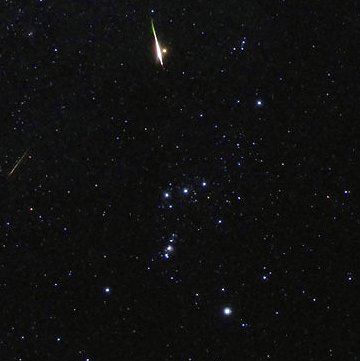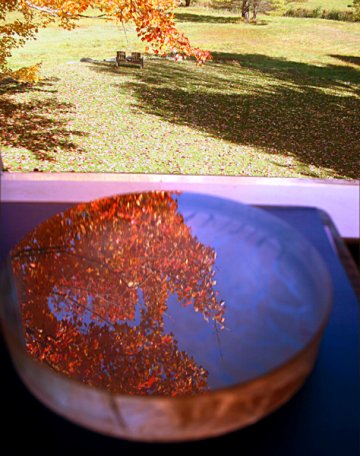 Where's Saturn? Is that a UFO--or the ISS? What's the name of that star? Get the answers from mySKY--a fun new astronomy helper from Meade. Where's Saturn? Is that a UFO--or the ISS? What's the name of that star? Get the answers from mySKY--a fun new astronomy helper from Meade. PROMINENCE ALERT: This morning, a beautiful prominence is dancing over the sun's northwestern limb: image. If you have a solar telescope, take a look!. more images: from Greg Piepol of Rockville, Maryland; ALOHA ORIONIDS! This weekend's Orionid meteor shower caused by dust from Halley's Comet was a dud in most places, but not in Hawaii. From high atop the Haleakala Summit on Maui, Rob Ratkowski sends this report: "On Oct. 21st, the shower produced about one meteor per minute, many arriving as closely-spaced pairs." Of all the Orionids he photographed, this one was best: 
Photo details: Nikon D200, 16mm, ISO 1000, Vixen GP-DX
"The fireball produced two flashes that lit up the ground and left a smokey trail that lingered for several minutes," says Ratkowski. A few islands away on Kauai, Dave Parkhurst had a similar experience: "We witnessed about 30 Orionids. Several of those were extremely bright and even burned slightly green at times." These sightings may signify a rich strand of comet dust that rained down over the Pacific. Or it may denote nothing more than the dark crystal-clear skies of high mountains and remote islands. Either way, Oct. 21st was a good night to be in Hawaii. more images: from Tom Martinez of Cleveland, Missouri; from Sylvain Weiller of Saint Rémy lès Chevreuse, France; from Doug Zubenel of Kansas; from Brian Emfinger of Ozark, Arkansas; from Chris Peterson of Guffey, Colorado; from Marsha Adams of Sedona, Arizona; from David Campbell of Hatfield, Hertfordshire, UK; FALL COLORS: "Fall foliage is peaking here in South Portland, Maine, and I decided to photograph the colors in an unusual way," says John Stetson. "Here they are reflected in the 6-inch hand-ground mirror of my next solar telescope." 
"This mirror is use in a solar telescope designed by John Dobson," he explains. "The polished and figured mirror will remain unsilvered." The sun is so bright, oridinary polished glass is reflective enough. "Also, without a reflective coating this mirror will be able to gather more than enough light to view the full moon this Thursday." Stay tuned for moonshots!
October 2007 Aurora Gallery
[September Gallery] [Aurora Alerts] | 
